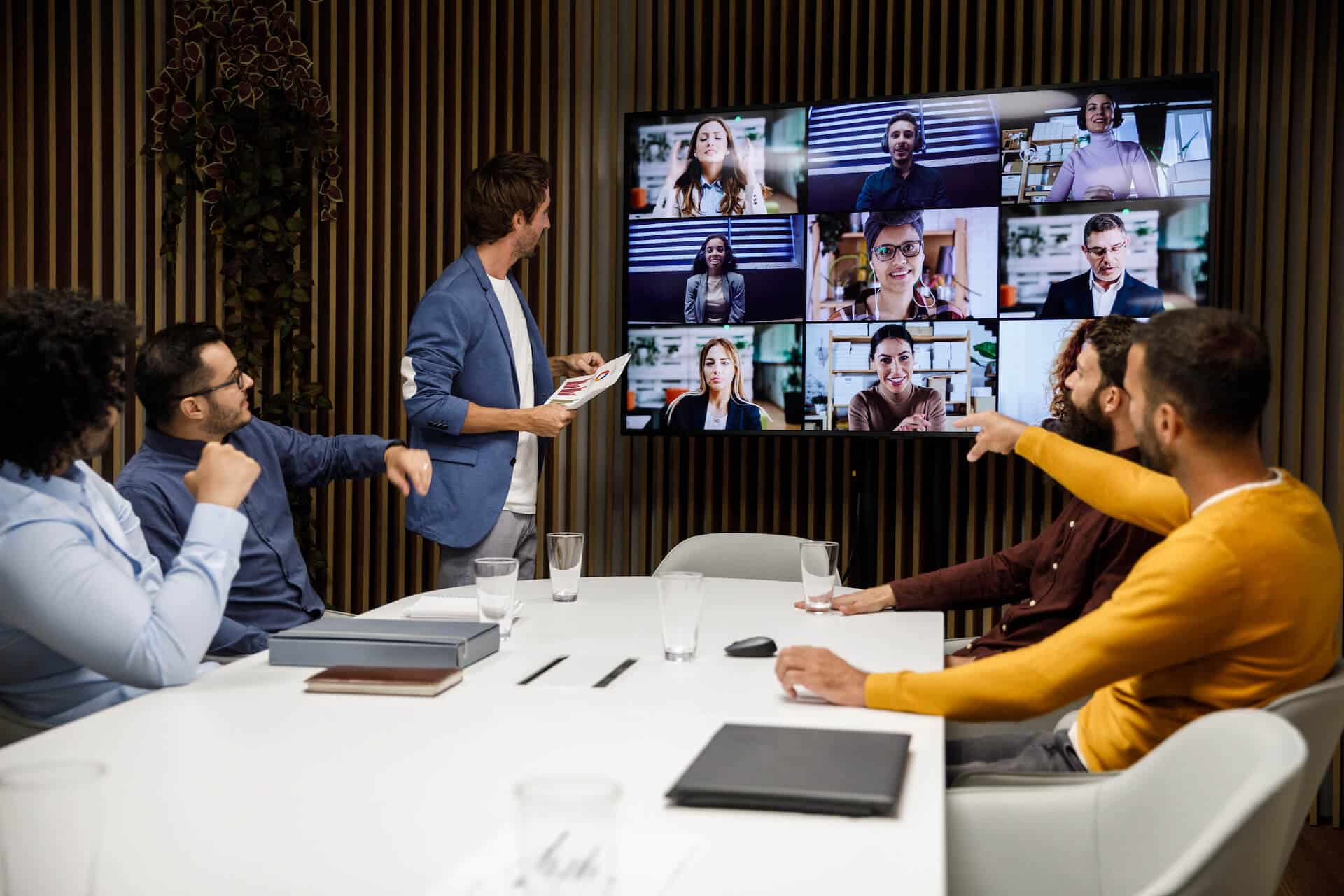There’s now no doubt that hybrid work is here to stay. That means hybrid challenges are here to stay, too. Both hybrid employees and hybrid leadership teams have had to adopt new ways of working, in response to an increasingly dynamic workplace and future of work.
In this article, we’re exploring hybrid leadership challenges in particular, including solutions to eight of the most common hybrid challenges facing leaders today.
What is hybrid leadership, and what challenges do you face when leading a hybrid team?
Like the name suggests, hybrid leadership is simply about leading teams in any variety of hybrid work model. Hybrid leaders need to be able to foster good working relationships and guide staff whether they’re working in-person, off-site, or in any combination of the two.
In other words, hybrid leadership is about managing and guiding a distributed workforce. This is where everyone works from a variety of locations (and potentially on a variety of varying hybrid schedules, too).
The first common challenge that virtually all new hybrid leaders face is also the most important. It’s figuring out what ‘hybrid’ will actually mean for their organization. ‘Hybrid’ and ‘flexible working’ are some of the biggest buzzwords going. But actually determining how to best apply them to your unique work environment can be a daunting task. And one that, as we’ll cover below, requires trial, error, and an ample dose of workplace agility.
But while they’re figuring out how to develop a new hybrid workplace strategy, hybrid leaders have to simultaneously help their people navigate an ever-evolving (and therefore potentially more stressful) hybrid work environment.
Yes, there are many benefits of working remotely and/or on a hybrid schedule.
But navigating change is inherently stressful.
Hybrid employees will be looking to their hybrid leaders to help them navigate all this change. All while improving workplace culture and promoting work-life balance to boot.
In short, improving the hybrid workplace experience has to be priority number one for anyone leading hybrid teams, and/or trying to overcome the many hybrid working challenges for employees.

8 Specific hybrid challenges for leadership teams (plus their solutions)
Like OfficeSpace CEO David Cocchiara writes for Forbes, all leaders need to plan for the future. And not respond to problems as they arise.
“The idea is to break out of problem-solving mode and work to solve problems before they arrive,” he says.
Of course, this can be more challenging in a brand new hybrid work arrangement. Understanding the many challenges of hybrid working for employers will be the first step towards overcoming them.
Specifically, here are eight hybrid leadership challenges, plus best practices for overcoming them.
Hybrid challenge #1: Maintaining—and improving—company culture
The challenge: According to a major new Gallup poll of today’s hybrid workers, 32% feel less connected to their company’s culture.
Meanwhile, only 47% of employees in a major Capgemini survey reported feeling included and heard during the pandemic.
And the latest research shows that up to 70% of employees think that remote workers may have fewer opportunities. Or that it might increase inequality or lead to a dual culture.
In short, when everyone is dispersed, it’s easy to create a real disconnect between leaders and employees, and between remote and in-office employees. This can erode company culture (impacting both talent retention and attraction efforts).
The solution: Provide people-centric leadership, and take a collaborative approach to team norms and employee engagement.
Note that among companies that have successfully navigated the transition to hybrid work, the vast majority of their employees report feeling empowered and trusted. Their employees also report that they believe their organization is invested in emotional and physical employee wellbeing, and that it is led with purpose.
In short, a positive culture is an employee centric culture, and one where leadership is as committed to improving their employee experience index as they are to their growth strategy or anything else.
Beyond working towards more inclusive company culture and workplace wellbeing, exploring all the options below should also help to foster a more connected culture among a hybrid workforce. Like Cocchiara writes in Forbes, “the goal is to create an environment in which teams thrive and a culture that people want to be part of.”
“We’re all responsible for the culture.”
OfficeSpace CEO David Cocchiara
Hybrid challenge #2: Understanding employee behavior (and using it to improve employee experience and workplace management)
The challenge: Leadership doesn’t have accurate visibility into employee behavior in an increasingly dynamic hybrid office.
This challenge arises when companies aren’t collecting meaningful data about how their employees are using the physical office. While this lack of data might have worked in a traditional office, it can significantly hamper a hybrid organization’s ability to optimize space, improve the hybrid experience, and/or right-size their real estate portfolio (and lock-in any associated cost savings).
What teams or departments are on-site the most? What type of workspaces are they gravitating to? Do you have a ghost room problem, or are people fighting over collaboration spaces? Being able to answer these questions is critical to workplace functionality. And they can only be answered with accurate, robust, and real-time metrics.
Meanwhile, for those companies that are actually collecting this workplace data, it often lives in silos. It’s never synthesized into meaningful workplace reports and analytics. So it can’t easily be used to make the workplace better or support real estate decisions.
The solution: Collect and use advanced workplace analytics to get a full picture into the truth of real office use.
“The dimensions of how people are using the office have changed dramatically,” says Kathleen Williams, Senior Product Manager at OfficeSpace. “If you want to understand how employees are interacting with the workplace, you need to rely more heavily on different data sources, like badging, WiFi data, and occupancy sensors. It’s too difficult to get your employees to report information themselves with a high fidelity that you can really trust.”
Specifically, the more sources of non-siloed data, the better hybrid leadership will be able to provide productive environments for everyone. These data sources can include:
- Desk and/or room reservations, check-ins, and cancellations
- Employee badge data
- Presence data from occupancy sensors and other IoT sensors
- Security and HR data
- Wifi logs
- Manual office census (i.e.: ‘walking the floor’)
- Tickets submitted through request management software
- Employee surveys
“With the right data management, you can make sure you have the right space for the right people.”
OfficeSpace Senior Product Manager Kathleen Williams
Hybrid challenge #3: Managing dispersed teams
The challenge: Remote and hybrid team members need extra guidance to navigate the new normal, but managing at a distance is incredibly challenging.
For example, hybrid meetings really only work when everyone follows hybrid meeting best practices, and when remote employees come in crystal clear over their webcams. But only 46% of companies are currently helping employees with remote work expenses. What good is a Zoom account, if you don’t have a good camera or reliable wifi?
The solution: Create (and communicate) clear expectations, and prioritize the right tools for distributed work.
It’s up to hybrid leaders to ensure everyone stays on the same page (remote teams included). This can only happen when everyone understands what that page is (i.e.: when they know what is expected of them).
“To ensure success, companies must communicate expectations properly,” Cocchiara writes in Forbes. “Whether it’s a formal guide for employees, a microsite or a regular email, clear and constant communication can reduce the level of confusion employees may have and quell any uneasiness they may be feeling.”
Of course, distance can make relationship building and communication difficult, even for the best of managers. That’s why Angie Earlywine, workplace strategist and Senior Director in the Total Workplace division of Global Occupier Services at Cushman & Wakefield, recommends that leadership ensures all managers have the right tools and training to perform their job effectively.
“There are best practices and nuances to managing a mixed remote and hybrid team,” she says. “And there are benefits to having regular training programs. Don’t assume managers don’t need training and that employees know how to not just survive, but thrive in this new model.”
Leadership can also benefit from collaborating more closely with HR than in the past to overcome any communication challenges. In particular, HR can help ensure that any new initiatives or other workplace changes are rolled out with clear and accessible messaging. HR can also help ensure employees feel heard and understood throughout the process.
Finally, hybrid leadership teams must ensure that the company is setting up all employees with the right tools. They must be able to communicate, collaborate, and ultimately perform their jobs well. Only 12% of hybrid leaders are confident that their team is productive. But what percentage of those who aren’t confident are actually taking steps to ensure that their people are well connected? And stocked with all the tools they need?
Specifically, hybrid leaders may want to lean on their IT department. This will help to ensure distributed teams all have what they need at home (or on the road). Many companies now also offer a stipend to workers that they can use to improve their home office.

Hybrid challenge #4: Creating the right hybrid model and schedule (that actually works)
The challenge: Adopting a hybrid approach and schedule that gives employees what they want, without sacrificing productivity or falling short of well-established business goals.
Employee surveys are important here (and employee input always matters). But when it comes to their schedules in particular, employees aren’t always the best predictors of their future behavior.
“A lot of companies have been asking employees what they want regarding the office,” says Williams. “But that’s a hard question for them to answer.”
What we know for sure is that what employees do want is as much flexibility as possible. Especially when it comes to when and where they work. But at the same time, according to a recent Gallup poll, 21% of hybrid workers said they find it difficult to coordinate work schedules, tasks, and timelines with those of their colleagues?
So how to offer flexibility without sacrificing teamwork and employee engagement?
The solution: Hybrid leaders need to leverage the true data about office use to create a flexible schedule that benefits everyone, and they need to give employees more visibility into their colleagues’ schedules.
“Ultimately, everyone is trying to answer the question of whether there could be a better fit between who’s coming into the workplace and the resources they have when they get there,” says Williams. “At the end of the day, employees need to be able to come together when the times are right for them to come together and collaborate. And they need to be allowed to work remotely or autonomously when the time’s right for that. That’s much harder to do, and it takes better data and visibility to make it possible.”
Meanwhile, while leaders collect (and analyze) this detailed data, they also need to give their employees a better window into the office. And into their colleagues’ schedules. A visual directory that’s accessible via mobile app (and/or via wayfinding kiosks) can help in two ways.
First, it can dramatically simplify wayfinding, connecting people to the people and resources they need right away.
Second, it can help employees overcome one of their biggest challenges. This is exemplified by the hybrid worker who told Vox, “if I go into the office and there are people but none of them are on my team, I don’t gain anything besides a commute.”
Namely, a visual directory can help employees see ahead of time when their colleagues will be in the office. This way, they can make their own plans accordingly.
For example, Who’s In, which works on any device, lets employees see a roster of who will be in the office at a date and time of their choosing. Then, without leaving the app, employees can choose to reserve a desk or collaborative workspace for when it makes sense for them to come into the office.
Hybrid challenge #5: Creating workspaces that work for everyone
The challenge: Creating the right types of workspaces for the employees who need them, wherever they need them, and available whenever they need them.
According to Gallup, 35% of hybrid workers report their top challenge is having less access to work resources and equipment. And we can only expect this challenge to continue in the post-pandemic office, as office use is increasingly dynamic (and therefore increasingly difficult to plan for).
“The pandemic totally flipped things on their head,” says Williams. “The dimensions of how people are using the office have changed dramatically. And without advanced workplace analytics tools, people won’t have a good idea of how to see what’s actually happening in their workplace, which is where data analytics comes in.”
The solution: Collaborate with facility managers (FMs) and other space planners to make data-driven plans for all aspects of the workplace.
FM responsibilities have been shifting since the pandemic, because FMs are primed to help power a more productive hybrid office. Using data and space management software, FMs and other space planners can help companies optimize a variety of work environment types.
Companies need new ways to create a better place for everyone based on their culture, operations and comfort level.
David Cocchiara, OfficeSpace
Hybrid challenge #6: Maintaining organizational agility
The challenge: As the pandemic taught us, the world of work can change quickly.
And according to Gallup’s Ghassan Khoury and Maria Semykoz, companies have to adapt to new technologies and workplace trends “or be swept aside.”
The solution: To maintain workplace agility, hybrid leaders must be open to change, and therefore open to testing out new ideas. And they need to understand that what works for one industry, company, department, or even team might not work for everyone. .
“There’s no signal answer of a perfect workplace that will work for every company or companies within an industry or region,” says Cocchiara. “I would even argue there’s probably not going to be a one-size-fits-all solution within a company.”
So instead of trying to create that perfect workplace, hybrid leaders instead need to figure out a way to be open to change, and open to testing and iterating solutions. Like Goldilocks, they need to be willing to try out new things! And maybe take a few risks before settling on what’s just right.
“The reality is you might not get things right the first time,” says Williams. “The future of the office is going to be a test-and-learn feedback loop.”
Note that empowering FMs and space planners with tools for both office scenario planning and office stack planning can dramatically simplify the testing process.
Hybrid challenge #7: New budget concerns
The challenge: Despite promises of cost-savings, if hybrid working isn’t managed properly, it might lead to more expenses, not less.
For example, like Clint Padgett, president and CEO of Project Success, tells The Enterprisers Project, “paying for high-speed internet for 100 different employees so they can work remotely from their homes is an added cost that will be incurred and doesn’t reduce or eliminate the need for bandwidth at the physical office.”
The solution: Offset any extra expenses with data-driven corporate real estate optimization.
Before the pandemic and wide-scale adoption of hybrid work, offices only used an average of 60% of their office space. Now, with employees using the office less frequently, companies should be able to spend less on their office space, too.
Specifically, leaders should ensure they have adequate real estate portfolio management. And that FMs are collecting metrics (like space utilization and office density, for example) that they can use to make better financial decisions come lease renewal dates.
Hybrid challenge #8: Boosting collaboration, communication, and connection
The challenge: Maintaining collaboration and communication in a world where workers are no longer face-to-face full time.
Without proper management, the hybrid hit to collaboration can be very real. For example, according to a new Gallup poll, 30% of hybrid workers said their top challenge was decreased team collaboration, and 24% said it was impaired cross-functional communication and collaboration.
The solution: Leadership can help employees stay connected by implementing the right tools and supporting them with the right approach.
Yes, this means cloud-based software (the usual suspects include Zoom, Microsoft Teams, Slack, Trello, and Asana). Better still if they can integrate with the previously mentioned visual directory and desk and room booking tools.
But introducing new technology in the workplace by itself isn’t enough.
Leadership needs to support that new technology with a collaborative culture. This can be boosted through things like all-hands meetings and social activities (all of which are just as possible via conferencing as they are in-person).
“Notably, the top challenges of hybrid work are far less prevalent than the top advantages. This indicates that the greatest advantages of hybrid work substantially outweigh the biggest challenges.”
Ben Wigert and Jessica White, Gallup

Hybrid leadership FAQs
How does a hybrid team work?
A hybrid team works by providing everyone on the team (whether they’re fully remote, fully in-office, or fully hybrid) with the tools, technology, and support they need to meaningfully engage with their given tasks and workday.
What makes a good hybrid team?
A good hybrid team is one that is supported with good managers and the right tools to stay connected both to each other and to their larger organization and work culture. This usually means a mix of cloud-based collaboration and communication technology. That’s along with software that allows them to see their colleagues’ schedules (and adjust their own accordingly).
How do you manage a hybrid work team?
To manage a hybrid work team, you need to create clear expectations for all team members. And, of course, you need to communicate them clearly. Managers must ensure employees the necessary tools, even when they’re working remotely. And they need to ensure that they have adequate and appropriate collaborative spaces available to them when they’re in-office. The best way to do this is by collecting (and analyzing) a wide variety of data about real-time office use.
How do you manage performance in a hybrid workplace?
There’s no one single way to manage performance in a hybrid workplace. Instead, organizations should ensure that anyone managing hybrid teams has extra training. This is along with clear guidelines of what will be expected of them and their team members.
What are the challenges you face as a hybrid leader?
The challenges you face as a hybrid leader center around understanding what employees need. This is from their organization, from their work culture, and from their physical office space. Hybrid leaders are responsible for ensuring that employees have everything they need to do their jobs well. No matter where they happen to be working on any given day. This is increasingly difficult the more dynamic a workplace is.
What qualities do leaders need to lead effectively in a hybrid environment?
New research shows that leading effectively in a hybrid environment requires higher KSA (knowledge, skills, and abilities) levels than leading in traditional environments. Specifically, hybrid leaders need better communication and organizational skills, along with more analytical and cognitive ability.

How do you overcome challenges in hybrid work?
The best way to overcome any challenges in hybrid work is as a team, with the right attitude, culture, and tools. Leadership is important, but leaders need to work closely with their people to create an open, agile culture that brings everyone together.
Specifically, the best way for hybrid leaders to overcome their challenges is to solicit feedback from employees about them. They can then combine this feedback with other data they’re collecting, and use that to build a good picture of where they are, and where they should be going.
OfficeSpace collects data and provides tools to simplify the office and overcome the biggest hybrid challenges. Reach out for a free demo.
Photos: fotostorm, Ivan Pantic, Sneksy, fotostorm, jacoblund





